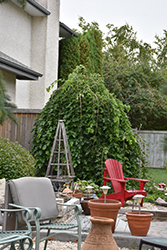Plant Library
Chaparral Weeping Mulberry
Morus alba 'Chaparral'
Height: 10 feet
Spread: 15 feet
Sunlight:
![]()
![]()
![]()
Hardiness Zone: 5a
Other Names: White Mulberry
Description:
A fruitless clone of the popular weeping mulberry, featuring a bushy, twisted and arching habit of growth, making it ideal for accent use; a little large for the average garden, so best used as a feature or specimen in the landscape
Ornamental Features
Chaparral Weeping Mulberry is primarily valued in the landscape or garden for its highly ornamental weeping form. It has emerald green deciduous foliage. The pointy leaves turn yellow in fall.
Landscape Attributes
Chaparral Weeping Mulberry is a multi-stemmed deciduous shrub with a rounded form and gracefully weeping branches. Its relatively coarse texture can be used to stand it apart from other landscape plants with finer foliage.
This shrub will require occasional maintenance and upkeep, and is best pruned in late winter once the threat of extreme cold has passed. It is a good choice for attracting birds to your yard. It has no significant negative characteristics.
Chaparral Weeping Mulberry is recommended for the following landscape applications;
- Accent
Planting & Growing
Chaparral Weeping Mulberry will grow to be about 10 feet tall at maturity, with a spread of 15 feet. It has a low canopy with a typical clearance of 1 foot from the ground, and is suitable for planting under power lines. It grows at a fast rate, and under ideal conditions can be expected to live for 40 years or more.
This shrub performs well in both full sun and full shade. It is very adaptable to both dry and moist locations, and should do just fine under average home landscape conditions. It is considered to be drought-tolerant, and thus makes an ideal choice for xeriscaping or the moisture-conserving landscape. It is not particular as to soil type or pH, and is able to handle environmental salt. It is highly tolerant of urban pollution and will even thrive in inner city environments. This is a selected variety of a species not originally from North America.


